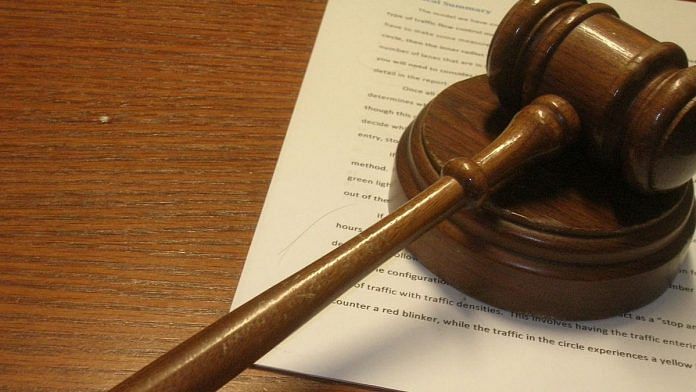New Delhi: A Mumbai court last week sentenced a 32-year-old man to life imprisonment on charges of cyber terrorism under the Information Technology Act, 2000, for conspiring in 2014 to attack the American School of Bombay in the city’s Bandra Kurla Complex area. This is the first conviction of cyber terrorism in Maharashtra,
The verdict was handed down by Additional Sessions Judge Dr A.A. Joglekar on 21 October.
According to the judgment, advocate Madhukar Dalvi, special public prosecutor for the State, had alleged that Anees Shakil Ahmed Ansari was conspiring to commit a “LONE WOLF bomb attack at an American School at BKC, Mumbai, with the intention of causing death of children of Foreign Nationals and thereby causing terror”.
The state’s Anti-Terrorism Squad (ATS) arrested Ansari in October 2014.
The prosecution had alleged that Ansari had made his plans by unauthorised usage of the computers and internet of a private company he worked for, “threatening the unity, integrity, security and sovereignty of India”. It was also alleged that Ansari was inducing others “to join him in spreading the terror activities propagated by the ISIS”.
In evidence, the prosecution had submitted Facebook chats of his fake account under the name “Usayrim Logan”. The “timeline profile”, the judgment said, also had photographs of “Statue of Liberty which was seen lying horizontal”, text related to Baghdad and ISIS, and a “diagram” of a bomb.
Finding him guilty of cyber terrorism, the court convicted him under Section 115 (abetment of an offence punishable with death or life term, if the offence is not committed), read with 120B (criminal conspiracy) of the Indian Penal Code (IPC), and Sections 43(a) (compensation for failure to protect data) and 66F (cyber terrorism) of the IT Act.
Section 66F defines cyber terrorism to include accessing a computer resource without authorisation or exceeding authorised access, with an “intent to threaten the unity, integrity, security or sovereignty of India or to strike terror in the people or any section of the people”.
Also Read: ‘Kind enough to let 4-yr-old live’ — Madhya Pradesh High Court’s language causes a furore
‘Lone wolf bomb attack’
According to the prosecution, the Nagpada ATS unit received intel from an informant on 18 October, 2014, that Ansari, who was working as an associate geographic technician, was a “jihadi” and had conspired to attack the American School at BKC. Ansari was then arrested.
During his employment with M/s. Here Solutions India Pvt. Ltd., at Seepz, Andheri, Mumbai, the prosecution alleged that he used the company computer and internet for making a Facebook account under a fake name. He then allegedly downloaded and posted objectionable material, and chatted with people about ISIS ideology. The prosecution also relied on his Facebook chats with one Omar Elhaj, which, they said, showed Ansari’s intention and preparation to attack the American school.
It alleged that Ansari had procured information about making a thermite bomb and had shared this information with Elhaj, “in furtherance of conspiracy of committing A LONE WOLF bomb attack at an American school at BKC, Mumbai, with the intent of causing death of children of foreign nationals and with malafide intentions of causing terror and threatening the unity, integrity, security or sovereignty of India”.
The court said that Ansari’s job profile did not require access to such information, and that he was warned against accessing social media sites, and so, he had “exceeded such authorised access” provided by his employer.
“The evidence tendered by the prosecution in the given case do certainly demonstrate that the accused knowingly and intentionally with an intent to threaten the unity, integrity, security or sovereignty of India or to strike terror in the people or any section of people by exceeding such authorized access and by means of such conduct obtains access to information which…may be used to cause or likely to cause injury to the interest of sovereignty and integrity of India…,” it concluded.
Also Read: SC no to tax exemption for ‘profit-minded’ educational institutions: Here’s what’s allowed
Attendance sheets, surfing Islamic websites
Among other things, the prosecution presented Ansari’s attendance time sheets, and a warning letter issued to him by the company, and had examined four of his colleagues as witnesses. As per the judgment, one of his colleagues told the court that Ansari was found using Facebook during work hours, and that the colleague also saw Ansari “opening some Islamic sites and downloading some contents”.
In his defence, Ansari had submitted that the prosecution had failed to prove how the company’s internet services were used by him to spread terror activities propagated by ISIS. His lawyer also contended that the prosecution had not proved that he had created the fake account himself, and that there was nothing to show that he was actually planning an attack or hatching any such scheme. However, the court rejected all such arguments and found him guilty.
Ansari’s lawyer had then demanded a minimal sentence for him, contending that he was arrested at a young age and that he was the sole earning member in his family. On the other hand, Dalvi had sought the maximum punishment of life imprisonment for Ansari, submitting that he is highly qualified, and if released, there was a possibility of him committing acts of cyber terrorism.
The court chose to award him life term, saying that he does not deserve “lenient and liberal consideration”.
(Edited by Anumeha Saxena)
Also Read: ‘Legal aid not just for namesake, should be effective, not a sham’: Why SC freed death row convict



